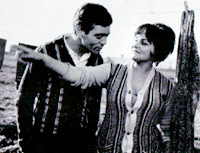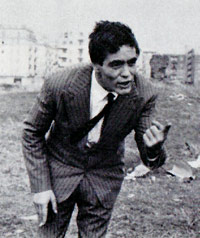 |
| WHATEVER HAPPENED TO... THE CLASS OF '62 |
 |
 BACK TO PAGE 1 BACK TO PAGE 1
Two of the strangest names to appear on the list are those of Brunello Rondi and Paolo Heusch, both of whom are far better known today - if they are known at all - for their more exploitative works. At the time, though, they had just completed the collaborative A Violent Life (Una vita violenta, 62) which, like La commare secca, was based on a premise by Pasolini. The laugh-a-minute story revolves around Tommaso (Franco Citti), the leader of a gang of youths who is sent to prison, contracts tuberculosis, joins the communists and dies. Despite the pessimistic subject matter, it proved surprisingly lucrative.
 |
Paolo Heusch and Brunello Rondi's A VIOLENT LIFE |
Quite how the collaboration between the two directors worked is a matter of conjecture, but they'd both had considerable experience in the film industry prior to this. Heusch had been assistant director on a good dozen films since 1949, and had also made the little known sci-fi feature The Day the Sky Exploded (La morte viene dallo spazio, 58). After this modest brush with social realism, he returned promptly to the genre treadmill with the cult favourite Werewolf in a Girl's Dormitory (62). Later efforts included The Desert Renegades (Una raffica di piombo, 66), the spy film Un colpo da mille miliardi (66) and a strange biography of El Che Guevara (68), with Francisco Rabal as the titular student icon. His films were generally well mounted despite their small budget, which makes it so curious that he seemingly disappeared in the early seventies. He did pop up as casting director for Tinto Brass's Caligula (79), which must have been a fun job but hardly counts as worthy of his aptitude.
 |
Franco Citta, star of the Italian new wave, in A VIOLENT LIFE |
Brunello Rondi had an equally curious career before his death in 1989. A writer and poet, as well as former assistant to both Federico Fellini and Roberto Rossellini, his cinematic pedigree was certainly without doubt, and with Il demonio (63) - a rural drama featuring Daliah Lavi and Frank Wolff - he continued making a name for himself. After this, however, things began following a more bizarre trajectory. Not that his films are bad, they're not, but they fall readily into the sex'n'horror category that was so unfashionable for the arthouse set. He made giallos (Più tardi, Claire, più tardi (68), Le tue mani sul mio corpo (70)), a Canterbury tales rip-off (Racconti proibiti… di niente vestiti (72)), a women in prison flick (Women's Prison (Prigione di donne, 74) and even a 'Black Emmanuelle' film (Smooth Velvet, Raw Silk (Velluto nero, 77)). Some of these are actually pretty good, and definitely worthy of more attention, but even his better known work counts as being obscure. Even while making these scurrilous little films, moreover, he kept his fingers in more mainstream cinema by continuing to act as a writer for Fellini on Satyricon (69) and City of Women (La città delle donne, 80).
So, what does all this tell us? Well, perhaps that there were an awful lot of filmmakers who were fêted early but never realized their ability. Of the named directors, only Bertolucci - and possibly Montaldo - can be said to have enjoyed a glittering career. And I haven't even covered some of the people mentioned in the article: Riccardo Fellini, Nicola Ferrari, Giancarlo Zagni and Piero Nelli, anyone? Perhaps also, though, it also demonstrates that the boundaries between art and exploitation were far narrower in the golden age of Italian cinema. All of these young tyros - yes, even Bertolucci - made films that could, to some extent, sit with equal happiness in either a repertory season or a cult aficionado's video collection. And that, my friends, is why I - for one - love these movies.
Matt B
If you would like to comment on this article, please go to the 'Directors of '62' thread in our forums.
|

